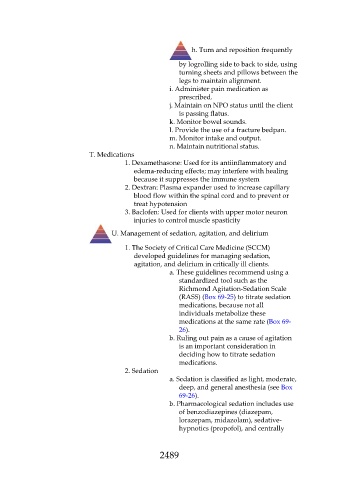Page 2489 - Saunders Comprehensive Review For NCLEX-RN
P. 2489
h. Turn and reposition frequently
by logrolling side to back to side, using
turning sheets and pillows between the
legs to maintain alignment.
i. Administer pain medication as
prescribed.
j. Maintain on NPO status until the client
is passing flatus.
k. Monitor bowel sounds.
l. Provide the use of a fracture bedpan.
m. Monitor intake and output.
n. Maintain nutritional status.
T. Medications
1. Dexamethasone: Used for its antiinflammatory and
edema-reducing effects; may interfere with healing
because it suppresses the immune system
2. Dextran: Plasma expander used to increase capillary
blood flow within the spinal cord and to prevent or
treat hypotension
3. Baclofen: Used for clients with upper motor neuron
injuries to control muscle spasticity
U. Management of sedation, agitation, and delirium
1. The Society of Critical Care Medicine (SCCM)
developed guidelines for managing sedation,
agitation, and delirium in critically ill clients.
a. These guidelines recommend using a
standardized tool such as the
Richmond Agitation-Sedation Scale
(RASS) (Box 69-25) to titrate sedation
medications, because not all
individuals metabolize these
medications at the same rate (Box 69-
26).
b. Ruling out pain as a cause of agitation
is an important consideration in
deciding how to titrate sedation
medications.
2. Sedation
a. Sedation is classified as light, moderate,
deep, and general anesthesia (see Box
69-26).
b. Pharmacological sedation includes use
of benzodiazepines (diazepam,
lorazepam, midazolam), sedative-
hypnotics (propofol), and centrally
2489

